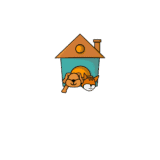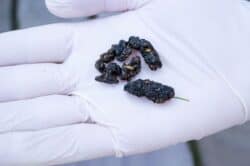Do you want to learn more about hedgehog pet poop?
My first interaction with my hedgehog pet’s poop issue was nasty, and I felt dreadful. I scolded myself for possibly going overboard with the variety of things I gave it. I believed I had given it the finest necessary for living a healthy life, but I think I was mistaken. When I took it to the vet, I understood stool condition may be caused by both starvation and poisoning. I’d like to share what I’ve learned with you and invite you to read What Friuts Can/Can’t Hedgehog Pet Eat
Here we go,
Hedgehog Pet Normal And Abnormal Poop
Hedgehog droppings differ depending on what they have eaten, but they all have a few qualities in common: Stools that are normal are elongated, have the form of a sausage, typically black, gray or dark brown color, 1.5 to 5 cm in length, firm but not hard, not too moist, and readily raised in one piece.
It is possible to have abnormal stool when it is Green in color which can be caused by excessive bile in the digestive system or improper digestion of meals. Stress, changes in nutrition or water, illness, or pancreatitis can all produce green and slimy skin.
What does healthy hedgehog pet poop look like
The excrement of a hedgehog is cylindrical in form and grows thinner as it gets closer to the finish. Poop is often black or brown in color and moist. It also has a shiny appearance from far
It’s worth noting that the color of your hedgehog excrement varies based on what your pet has just eaten. It is often black in hue, with sparkling beetle wings and berries. The excrement of a hedgehog mimics that of a carnivorous animal. When a Hedgehog steps on them, their feces should not break into bits, but they should also not be dried. If your pet is healthy, it will produce a similar color pellet on a regular basis.
How Do I Know If My Hedgehog Has Parasites
The four-legged buddy exhibits diverse symptoms based on the type and intensity of the infestation. Infestation symptoms include general malaise, vomiting, stomach discomfort, and diarrhea.
If your hedgehog exhibits these symptoms and is not gaining weight while eating plenty of food, you should visit a veterinarian. The veterinarian can determine whether your hedgehog has a parasite by studying the excrement in the laboratory.
Stool tests will be performed by the veterinarian to determine which and how many types of intestinal parasites the hedgehog has. The test will be redone if the stool test is negative but the result is dubious. He will next proceed with de worming, using molecules and doses approved for hedgehogs. Treatment differs based on the parasite.
Why Is My Hedgehogs Pet Poop Runny
Inadequate nutrition, a change in food or water, infection, pancreatitis, allergies, irritable bowel syndrome, and internal parasites are all possible causes of runny poop in your pet
Temporary diarrhea can also be caused by acute stress or another psychological stimulus. However, if the diarrhea lasts more than two days, worsens, and the animal’s overall health changes substantially, something more severe is at work. It might be an infection, a parasitic infestation, or, worst case scenario, an organic cause. Take the hedgehog to the vet as soon as possible so that the reason of the diarrhea may be determined.
Getting animal lovers to put down milk dishes is a classic blunder. Because hedgehogs are lactose intolerant, this kind gesture causes widespread distress among individuals who desire to spice up their pets drink. When hedgehog pets consume milk, they experience nausea, vomiting, and diarrhea. Diarrhea is defined as the emission of soft or liquid feces. Poisons and drugs like antibiotics can also induce diarrhea in hedgehogs.
Prolonged diarrhea is highly hazardous to the hedgehog because it causes dehydration
Keep a close eye on the animal’s condition, make sure it gets adequate water, and feed it soft food. If the diarrhea lasts longer than two days, take the animal to the doctor with a fresh stool analysis.
How Do You Treat Diarrhea In Hedgehogs
As a precaution, you should not feed your hedgehog for a day after it has defecated the first watery feces. This causes the gut mucosa to relax. Ensure that your dog is consuming enough of water throughout this time. Boiling water, fennel or chamomile tea is ideal here.
After 24 hours, you can feed your four-legged pet light food in tiny amounts or a special diet meal. The hedgehog’s diarrhea will usually clear up on its own within two days.
Focus on insects with natural nutrients to regulate the stool. In addition to crickets, the hedgehog need around 10-12 cockroaches at a time (at the average rate of 4-5 each feeding). Cockroach excrement is completely dry, and chitin cleans the intestinal walls.
If the diarrhea does not cease after dining on cockroaches, contact your veterinarian immediately and bring excrement with you for analysis. Under a microscope, the doctor may examine the existence of worms on the site. If no worms are identified, the feces are submitted to a lab for examination.
How do you prevent diarrhea in hedgehogs
Preventive measures include
- Keeping your hedgehog in a peaceful environment and never feeding it “no-eat” foods from the hedgehog food list. You can read more on this on What Do Hedgehogs Pets Eat And Drink
- Also, be sure to touch it with clean hands and clean the cage on a regular basis to prevent bacteria from forming.
- Change feed as infrequently and gently as feasible. Switching too rapidly might be harmful to the animal’s gastrointestinal tract.
- When feeding your hedgehog with wet food, take care not to leave it outside for too long. This is due to the possibility of spoilage of the feed.
- If your hedgehog has diarrhea for more than 24 hours, call your veterinarian for further information.
- You may need to take your hedgehog in for testing to verify he does not have gastrointestinal problems or parasites.
- Regular immunizations and de worming prevent the velvet paw against parasite infection and the complications that come with it.
- To minimize serious adverse effects, only provide medicine after contacting a veterinarian or other qualified individual.
- Your hedgehog’s residence should be designed in a welcoming manner. There must be no materials that are easily swallowed lying about, and no harmful plants or detergents should be accessible to the animal.
- As a pet owner, you should be prepared with the most significant diarrhea home treatments and electrolyte mixes. This means you may provide emergency care from the comfort of your own home. I did not have this idea with my hedgehog diarrhea issue and it really took me off balance
Is Hedgehog Feces Toxic To Humans
Yes, the feces of a hedgehog is toxic to humans. Clostridium, a bacterial infection, is one of the most common hazards detected in hedgehog feces. The excrement of a hedgehog infected with clostridium bacteria will be greenish in color and sticky. It is vital to understand that this virus is a zoonotic disease that comes in distinct forms. Humans can become infected with these bacteria in two ways: directly or indirectly.
Clostridium infection is known as Clostridium Difficile, abbreviated as ‘C difficile’ in humans. It has an effect on our gut and can produce diarrhea or serious inflammation to us as well. In the worst-case scenario, it can lead to renal failure or an increase in white blood cell count.
How to Handle Hedgehog Pet Feces Correctly
The first and most fundamental guideline is never to touch excrement with your bare hands. And keep your children away from the crap. To dispose of excrement securely, follow these procedures.
- Wear a rubber glove and, if feasible, a disposable surgical mask.
- Spray the excrement with water first if it has dried up.
- Clean up excrement off the surface with a hand trowel and bury it in your backyards away from water sources.
- Clean the place where the excrement was with a disinfectant.
- Wash your hands thoroughly in running water with soap.
Hedgehog droppings should never be disposed of in the compost, no matter how enticing it may appear. It should always be placed in a tiny plastic bag before being disposed of in the residual trash container.
If a hedgehog has left its traces on paved surfaces such as walkways or terraces, they are quite easy to remove. The simplest method is to utilize a cat litter scoop, which can be purchased for a modest charge from specialized stores. This little shovel is inserted exactly beneath the hedgehog droppings before being removed.
Conclusion
It is critical to remember that the color of your pet’s excrement says volumes about its health. If the hedgehog is not in good health, the excrement will become runny and discolored. A precise treatment should be provided so that your pet may get back on its feet. I invite you to read my post about Hedgehog pet litter requirements, which will provide you with the finest methods for caring for your pet’s waste I also recommend reading my post about Hedgehog pet bedding needs, which will provide you with the greatest beddings for your pet to live a pleasant life.

